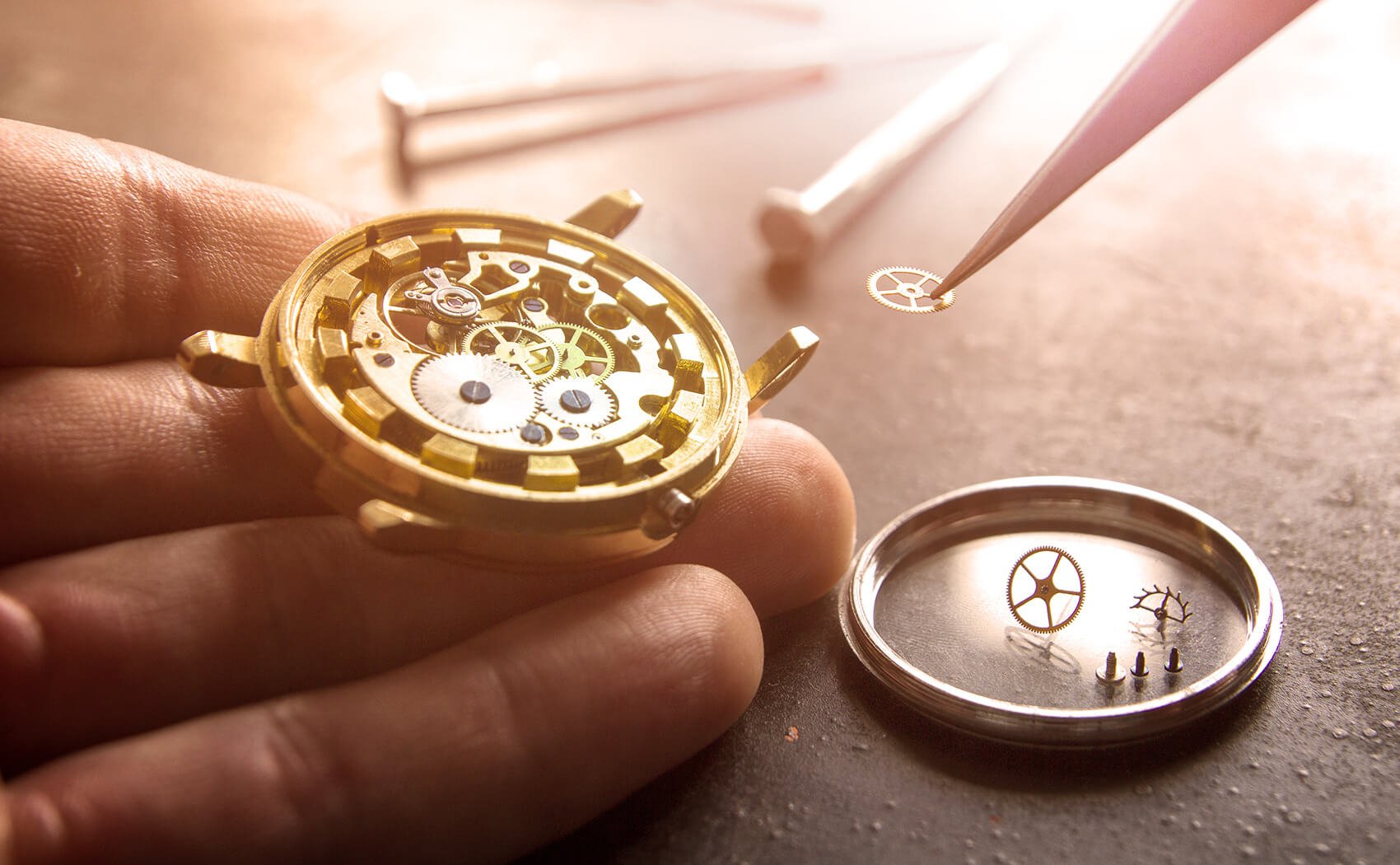Keep your timepiece ticking like clockwork with this guide on watch repair.
*NOTE: In this blog, we’ll be discussing the functionality of mechanical watches and automatic watches — those powered by winding, as opposed to quartz watches, which run by battery power.*
Having trouble with your mechanical or automatic watch? With a machine so intricately detailed, it’s no surprise that things can sometimes get off-track. From running too fast to not running at all, issues can arise from even the smallest mechanical errors. Due to the specialized nature of these amazing machines, most watch issues call for the assistance of a professional.
But before you take your watch in, it helps to know a bit about how its mechanisms work so you can better communicate with your watch repair technician or horologist. Read on for a basic breakdown of a timepiece’s functionality, and a list of common issues that can arise. Once you have a sense of how your watch keeps ticking, you’ll be better equipped to talk shop with the pros — including our staff of certified watch experts at myjewelryrepair.com.

How it Works
While luxury watches like Patek Philippe, Rolex, Omega, and Tag Heuer often come with many bells and whistles (“complications,” in watch-speak), their basic functionality is the
same as the simplest wristwatch. And while the simplest wristwatch may appear plain, behind its face lies an intricate system of springs, gears, wheels, and bearings that work together to keep you on time.
This system is known as the watch movement, and it consists of 4 main components: the mainspring, the wheel-train, the escapement, and the balance wheel. While every brand has its own unique approach to constructing its watches’ respective movements, all watches contain the same general mechanisms. Here’s an overview of how each component works, and how to diagnose a problem:
1. Mainspring
This tiny coil serves as the power source of your watch. When you wind a watch — either by hand in mechanical models or by wrist movement in automatic pieces — the mainspring tightens, storing up mechanical energy that, when released, activates the gears that operate the second, minute, and hour hands of your watch.
2. Wheel Train
The wheel train is a set of 5 gears that work together to temper the power provided from the mainspring. When the mainspring coil releases, it provides energy that sets off the first of these five gears. The gears are structured in different sizes, with different numbers of notches to convert this power into controlled units of time. The second, minute, and hour hands of your watch make up three of these five gears.
3. Escapement
The escapement is essentially a “stopper” that divides the motion of the wheel train into regular, measured increments of time. It interacts directly with the fifth gear of the wheel train — the escape wheel — and the balance wheel (see below) to temporarily obstruct motion of the gears in a fixed rhythm. It is the escapement’s interaction with the escape wheel and balance wheel that gives the watch its distinctive “tick-tock” sound.
[The balance wheel/escapement is easier to view in a clock]4. Balance Wheel
Set on a tiny torsion spring (hairspring), the balance wheel works directly with the escapement in a cycle: As the escapement temporarily stops each gear of the escape wheel, it transfers energy from the gear to the balance wheel, moving the wheel back and causing the hairspring to coil for half a second. As the spring uncoils for another half-second, the balance wheel moves back to reactivate the escapement, which, in turn, moves the escape wheel gear one notch forward per second. This back-and-forth motion between the balance wheel and escapement creates the “tick-tock” of a watch.

How to Keep Your Watch in Order
Most of these problems can be avoided with regular maintenance. Experts recommend getting your watch serviced every three to five years — especially for luxury watch brands, heirloom watches, or antique watches. A short visit every few years will maintain the efficiency and value of your timepiece. Take care of your watch, and you can be sure it’ll keep time for a long time.
For watch maintenance or repair, it’s imperative that you take your timepiece to a vetted watch professional. Myjewelryrepair.com works with certified horologists all over the country to ensure your timepiece gets the best treatment, with minimal effort on your part. Simply fill out the form on [link], schedule courier pickup, and send in your watch. Within three weeks, you’ll receive your watch, in tiptop, tick-tock shape.
Having trouble with your mechanical or automatic watch? With a machine so intricately detailed, it’s no surprise that things can sometimes get off-track. From running too fast to not running at all, issues can arise from even the smallest mechanical errors. Due to the specialized nature of these amazing machines, most watch issues call for the assistance of a professional.
But before you take your watch in, It helps to know a bit about how its mechanisms work so you can better communicate with your watch repair technician or horologist. Read on for a basic breakdown of a timepiece’s functionality, and a list of common issues that can arise. Once you have a sense of how your watch keeps ticking, you’ll be better equipped to talk shop with the pros—including our staff of certified watch experts at myjewelryrepair.com.
